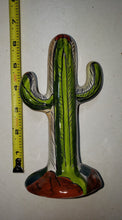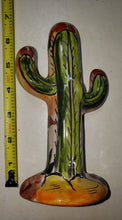Talavera pottery (Spanish: Talavera poblana) is a Mexican and Spanish pottery tradition from Talavera de la Reina, in Spain. The Mexican pottery is a type of majolica (faience) or tin-glazed earthenware, with a white base glaze typical of the type.[1] It comes from the town of San Pablo del Monte (in Tlaxcala) and the cities of Puebla, Atlixco, Cholula, and Tecali (all these four latter in the state of Puebla), because of the quality of the natural clay found there and the tradition of production which goes back to the 16th century.[2] Much of this pottery was decorated only in blue, but colors such as yellow, black, green, orange and mauve have also been used.[3] Majolica pottery was brought to Mexico by the Spanish in the first century of the colonial period. Production of this ceramic became highly developed in Puebla because of the availability of fine clays and the demand for tiles from the newly established churches and monasteries in the area. The industry had grown sufficiently that by the mid-17th century, standards and guilds had been established which further improved the quality, leading Puebla into what is called the "golden age" of Talavera pottery (from 1650 to 1750).[2] Formally, the tradition that developed there is called Talavera Poblana to distinguish it from the similarly named Talavera pottery of Spain. It is a mixture of Italian, Spanish and indigenous ceramic techniques.
The tradition has struggled since the Mexican War of Independence in the early 19th century, when the number of workshops were reduced to less than eight in the state of Puebla. Later efforts by artists and collectors revived the craft somewhat in the early 20th century and there are now significant collections of Talavera pottery in Puebla, Mexico City and New York City. Further efforts to preserve and promote the craft have occurred in the late 20th century, with the introduction of new, decorative designs and the passage of the Denominación de Origen de la Talavera law to protect authentic, Talavera pieces made with the original, 16th-century methods.




